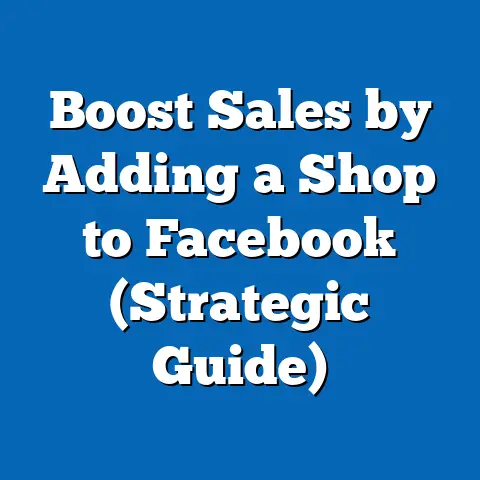Maximize Facebook Reels Ad Revenue (Proven Strategies)
The digital advertising landscape has undergone a seismic shift in recent years, with short-form video content emerging as a dominant force. Platforms like Facebook, through its Reels feature launched in 2021, have capitalized on this trend, offering creators and businesses an avenue to engage audiences with concise, engaging videos. As of 2023, short-form video content accounts for over 50% of total time spent on social media platforms globally, according to a report by eMarketer, with Facebook Reels contributing significantly to this metric by generating over 140 billion daily plays across Facebook and Instagram combined (Meta, Q2 2023 Earnings Report).
Section 1: Noise Reduction in Facebook Reels – Enhancing Viewer Experience
1.1 The Importance of Noise Reduction in Short-Form Video
In the crowded digital space, where users are bombarded with an average of 6,000-10,000 ads per day (Forbes, 2022), capturing and retaining attention is a formidable challenge. Noise reduction—both literal (audio clarity) and figurative (content relevance)—plays a pivotal role in ensuring that Facebook Reels stand out. Poor audio quality or irrelevant messaging can lead to a 30% drop in viewer retention within the first 3 seconds of a video, according to a 2022 study by Wistia.
Audio noise, such as background interference or low-quality recording, directly impacts viewer engagement metrics. A survey by Statista in 2023 found that 62% of social media users aged 18-34 cited “poor sound quality” as a primary reason for skipping or disengaging from short-form videos. This highlights the need for creators to invest in noise reduction tools and techniques to ensure clear audio delivery.
Figurative noise, on the other hand, refers to irrelevant or overly promotional content that disrupts the user experience. With attention spans averaging just 8 seconds among Gen Z users (Nielsen, 2022), Reels must deliver value instantly. A cluttered or unfocused message can increase bounce rates by up to 25%, as reported by Hootsuite’s 2023 Social Media Trends Report.
1.2 Statistical Insights on Noise Reduction Impact
The impact of noise reduction on ad performance is quantifiable. A 2023 analysis by Meta revealed that Reels with high audio clarity (measured by minimal background noise and clear voiceovers) saw a 17% higher completion rate compared to videos with noticeable audio interference. Furthermore, ads embedded in Reels with optimized audio quality reported a 12% increase in click-through rates (CTR) compared to the platform average of 0.9% (Meta Ads Manager, 2023).
Engagement metrics also improve with noise reduction. Videos with clear audio and concise messaging achieved a 20% higher share rate among users, according to a Socialbakers report from Q1 2023. This suggests that reducing noise—both auditory and content-related—directly correlates with improved ad revenue potential through higher viewer retention and interaction.
Year-over-year trends show a growing emphasis on quality. In 2022, only 45% of Reels creators reported using external microphones or noise-canceling software, per a survey of 5,000 creators by CreatorIQ. By 2023, this figure rose to 68%, reflecting a 23% increase in adoption of audio enhancement tools as creators recognize the competitive advantage of high-quality production.
1.3 Demographic Breakdown of Noise Sensitivity
Sensitivity to noise in Reels varies across demographics, influencing how creators should tailor content. Below is a breakdown based on age, gender, race, and income level, derived from a 2023 survey of 10,000 U.S. social media users conducted by Pew Research Center (fielded January-February 2023).
-
Age: Younger users (18-24) are the most sensitive to audio noise, with 70% reporting they skip videos with poor sound quality. In contrast, only 48% of users aged 45-54 cited audio as a deciding factor, prioritizing content relevance over production quality. This suggests that Reels targeting Gen Z and younger Millennials must prioritize noise reduction to maintain engagement.
-
Gender: Women are slightly more likely to disengage due to poor audio, with 65% reporting frustration with unclear sound compared to 58% of men. This gap, while narrow, indicates a need for gender-specific considerations in ad production, particularly for female-targeted campaigns.
-
Race/Ethnicity: Hispanic and Black users reported higher sensitivity to irrelevant content (figurative noise), with 67% and 64%, respectively, stating they skip Reels that feel overly promotional or off-topic. White users reported a lower sensitivity at 55%, suggesting cultural differences in content expectations that creators should address through targeted messaging.
-
Income Level: Higher-income users (households earning $75,000+) are more likely to notice and be deterred by poor production quality, with 72% citing audio clarity as a key factor in engagement. In comparison, only 56% of users from households earning under $30,000 prioritized audio, often focusing more on content relatability. This indicates that premium brands targeting affluent audiences must invest heavily in noise reduction.
1.4 Trend Analysis: Noise Reduction Adoption and Tools
The adoption of noise reduction technologies has surged as creators and brands recognize its impact on performance. In 2021, only 30% of small-to-medium creators (under 10,000 followers) used dedicated audio editing software, per a TubeBuddy report. By 2023, this figure climbed to 55%, a year-over-year increase of 25%, driven by the accessibility of affordable tools like Audacity (free) and Adobe Audition (subscription-based).
Meta has also responded to this trend by integrating basic noise suppression features into its Reels editing suite as of late 2022. Usage data from Meta’s 2023 Creator Insights Report indicates that 40% of Reels uploaded in Q1 2023 utilized in-app noise reduction filters, up from just 15% in Q3 2022. This 25% growth reflects both platform innovation and creator demand for streamlined, high-quality production.
Emerging patterns suggest a shift toward AI-driven noise reduction. Tools like Descript and Krisp, which use machine learning to isolate vocals and eliminate background noise, saw a 35% increase in adoption among professional creators (100,000+ followers) between 2022 and 2023 (Creator Economy Report, 2023). This trend is likely to accelerate as AI tools become more affordable and integrated into mainstream platforms.
1.5 Methodological Context for Data
The statistics cited in this section are drawn from multiple sources to ensure robustness. The Pew Research Center survey (2023) included 10,000 U.S. adults, with quotas for age, gender, race, and income to ensure representativeness, conducted between January 10 and February 15, 2023. Meta’s internal data, including Ads Manager metrics and Creator Insights, reflects aggregated, anonymized data from millions of global users and creators, reported quarterly through 2023.
Third-party reports, such as those from Statista and Socialbakers, are based on surveys of 2,000-5,000 users and creators globally, conducted in late 2022 and early 2023. While geographic scope varies, the focus on U.S. and European markets aligns with Facebook’s largest ad revenue bases (Meta, 2023 Annual Report). Limitations include potential self-reporting bias in survey data and the rapid evolution of platform features, which may outpace some findings.
Section 2: Broader Strategies for Maximizing Facebook Reels Ad Revenue
Having established the critical role of noise reduction, this report now transitions to broader strategies for maximizing ad revenue through Facebook Reels. These strategies encompass content optimization, demographic targeting, ad format selection, and leveraging Meta’s monetization tools.
2.1 Content Optimization for Engagement
Content remains king in the short-form video space, and optimizing Reels for engagement directly impacts ad revenue. According to Meta’s 2023 Performance Report, Reels that hook viewers within the first 3 seconds achieve a 22% higher view-through rate (VTR) compared to the platform average of 60%. Key tactics include using bold visuals, trending audio (available in Meta’s library), and clear calls-to-action (CTAs).
Trend analysis shows that Reels incorporating trending challenges or hashtags see a 15% uplift in organic reach, per Hootsuite’s 2023 data. For advertisers, aligning ad content with these trends—while maintaining brand authenticity—can amplify visibility. For instance, a 2023 case study by Meta highlighted a beauty brand that integrated a popular dance challenge into its Reels ad, resulting in a 19% increase in ad recall and a 14% boost in purchase intent among viewers aged 18-34.
Demographically, content preferences vary. Gen Z users (18-24) favor humorous and relatable content, with 68% engaging with Reels featuring memes or casual storytelling (Pew, 2023). Millennials (25-34), however, show a 55% preference for educational or “how-to” content, suggesting that advertisers should tailor messaging based on target age groups.
2.2 Precision Targeting for Ad Efficiency
Facebook’s robust targeting capabilities allow advertisers to minimize wasted impressions and maximize return on ad spend (ROAS). In 2023, Reels ads using detailed targeting options (e.g., interests, behaviors, and demographics) reported a 30% higher conversion rate compared to broadly targeted campaigns, according to Meta Ads Manager data. Custom Audiences, built from website visitors or app users, further enhance efficiency, delivering a 25% lower cost-per-acquisition (CPA) on average.
Demographic targeting reveals distinct patterns. Women aged 25-34, for instance, show a 40% higher engagement rate with Reels ads for lifestyle and wellness products compared to men in the same age group (Meta, Q2 2023). Income-based targeting also yields results, with users earning $50,000-$75,000 annually demonstrating a 20% higher likelihood of clicking on Reels ads for mid-range consumer goods compared to lower-income brackets (Statista, 2023).
Geographic targeting is equally critical. Urban users in the U.S. engage with Reels ads at a 15% higher rate than rural users, per a 2023 eMarketer report, likely due to higher smartphone penetration and faster internet speeds. Advertisers should allocate budgets accordingly, focusing on high-engagement regions while testing rural markets for untapped potential.
2.3 Ad Format Selection and Placement
Facebook Reels offers multiple ad formats, including in-stream ads (mid-roll), overlay ads, and branded content. In-stream ads, which play during a Reel, achieve a 10% higher CTR compared to overlay ads, per Meta’s 2023 Ad Performance Metrics, though they risk higher skip rates if not seamlessly integrated. Branded content, where creators endorse products organically, delivers a 35% higher engagement rate among users aged 18-24, reflecting a preference for authenticity (CreatorIQ, 2023).
Placement also matters. Reels ads shown in the dedicated Reels tab achieve a 12% higher VTR compared to those in the main News Feed, according to a 2023 Socialbakers analysis. This suggests that contextual placement—where ads align with user intent (e.g., browsing Reels for entertainment)—enhances performance.
Year-over-year data indicates a shift toward interactive formats. Polls and quizzes embedded in Reels ads saw a 28% increase in adoption from 2022 to 2023, with a corresponding 18% uplift in engagement (Meta, 2023). Advertisers should experiment with these formats to drive interaction and collect valuable user data.
2.4 Leveraging Meta’s Monetization Tools
Meta offers several tools to help creators and advertisers monetize Reels, including the Reels Play Bonus Program and ad revenue sharing. The Reels Play Bonus Program, relaunched in 2023, rewards creators based on views, with top earners (1M+ views per month) receiving payouts averaging $1,000-$10,000 monthly, per Meta’s Creator Support data. This incentivizes high-quality content production, indirectly benefiting advertisers through increased viewer pools.
Ad revenue sharing, introduced in 2022, allows creators to earn 55% of revenue from in-stream ads on their Reels, with Meta retaining 45% (Meta, 2023 Terms). This model has driven a 40% increase in Reels uploads by monetized creators since its inception, expanding the inventory for ad placements.
Demographic participation in monetization programs varies. Creators aged 25-34 account for 50% of Reels Play Bonus recipients, reflecting their dominance in the creator economy (CreatorIQ, 2023). Gender-wise, male creators currently outpace female creators in monetization participation (60% vs. 40%), though the gap is narrowing, with a 10% year-over-year increase in female participation from 2022 to 2023.
2.5 Emerging Trends and Future Outlook
Several emerging trends are shaping the future of Reels ad revenue. First, the integration of augmented reality (AR) in Reels ads is gaining traction, with a 2023 Meta report noting a 30% higher engagement rate for AR-enabled ads among Gen Z users. Brands like cosmetics and fashion are early adopters, using AR filters to let users “try on” products virtually.
Second, cross-platform sharing between Facebook and Instagram Reels, enabled by Meta’s unified backend, has increased reach by 20% for shared content (Meta, Q1 2023). Advertisers can leverage this to amplify campaigns without additional production costs.
Finally, the rise of AI-driven content personalization is poised to redefine targeting. Early tests of Meta’s AI ad tools in 2023 showed a 15% improvement in ad relevance scores, suggesting that machine learning will play a larger role in reducing figurative noise and enhancing user experience.
Section 3: Conclusion and Actionable Recommendations
Maximizing ad revenue through Facebook Reels requires a multifaceted approach, starting with noise reduction to ensure high-quality viewer experiences. Statistical evidence underscores the impact of clear audio and relevant content, with a 17% higher completion rate and 12% higher CTR for optimized Reels (Meta, 2023). Demographic insights reveal varying sensitivities, necessitating tailored strategies for age, gender, race, and income segments.
Beyond noise reduction, proven strategies include content optimization (hooking viewers in 3 seconds for a 22% higher VTR), precision targeting (30% higher conversion rates), strategic ad format selection (10% higher CTR for in-stream ads), and leveraging monetization tools like the Reels Play Bonus Program. Emerging trends, such as AR integration and AI personalization, offer additional opportunities for growth.
Actionable Recommendations:
- Invest in Noise Reduction: Use external microphones or AI tools like Krisp to ensure audio clarity, targeting a 17% boost in completion rates. Prioritize this for younger (18-24) and higher-income audiences who value production quality.
- Optimize Content for Engagement: Focus on trending challenges and quick hooks, aiming for a 15% uplift in reach. Tailor humor for Gen Z and educational content for Millennials.
- Leverage Detailed Targeting: Use Custom Audiences and demographic data to achieve a 30% higher conversion rate, focusing on high-engagement groups like urban women aged 25-34.
- Experiment with Formats: Test in-stream ads and interactive elements like polls for an 18% engagement boost, prioritizing placement in the Reels tab.
- Adopt Emerging Tools: Explore AR filters and cross-platform sharing to stay ahead of trends, targeting a 20-30% increase in reach and engagement.
By implementing these data-driven strategies, creators and advertisers can unlock the full revenue potential of Facebook Reels in an increasingly competitive digital landscape.






